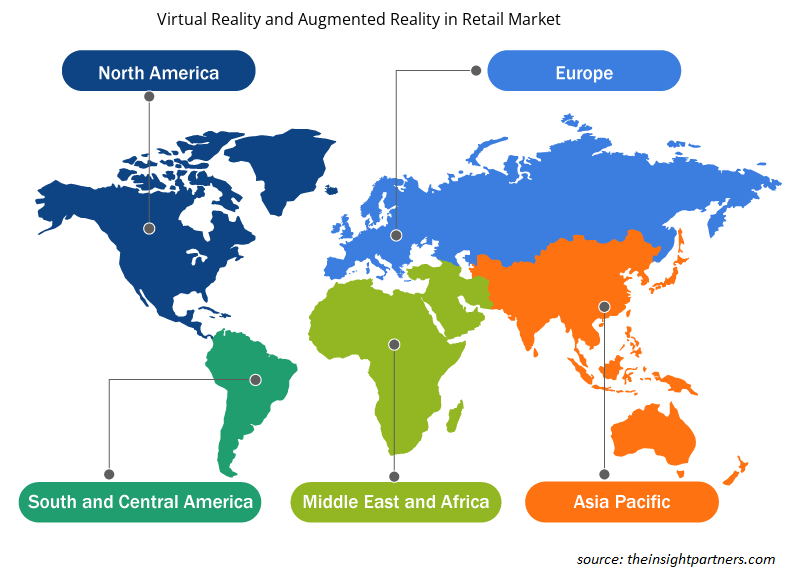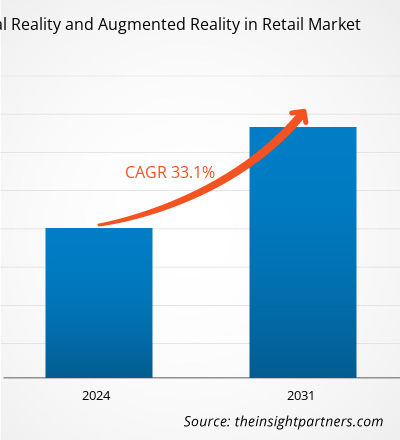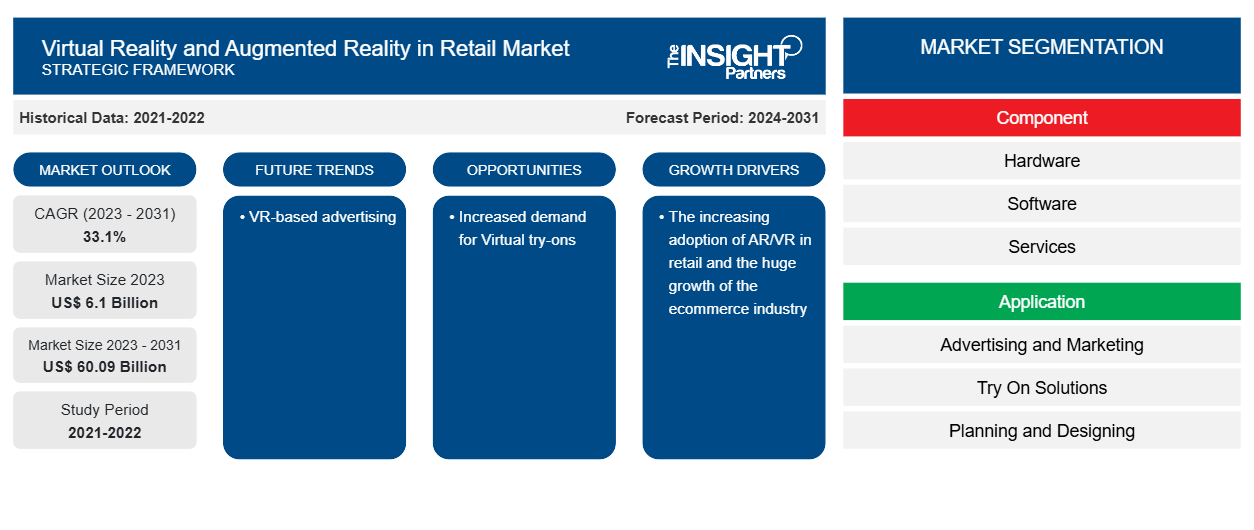Der Umfang von Virtual Reality und Augmented Reality im Einzelhandel wird voraussichtlich von 6,1 Milliarden US-Dollar im Jahr 2023 auf 60,09 Milliarden US-Dollar im Jahr 2031 anwachsen. Für den Einzelhandelsmarkt wird für den Zeitraum 2023–2031 eine durchschnittliche jährliche Wachstumsrate von 33,1 % erwartet. VR-basierte Werbung dürfte ein wichtiger Trend auf dem Markt bleiben.
Virtual Reality und Augmented Reality in der Einzelhandelsmarktanalyse
Virtual Reality und Augmented Reality im Einzelhandel bieten aufgrund der aktuellen Markttrends und ihrer vorhersehbaren Auswirkungen im Prognosezeitraum Wachstumsaussichten. Virtual Reality und Augmented Reality im Einzelhandel wachsen aufgrund von Faktoren wie der zunehmenden Einführung von AR/VR im Einzelhandel und dem enormen Wachstum der E-Commerce-Branche. Die gestiegene Nachfrage nach virtuellen Anproben bietet lukrative Möglichkeiten für Virtual Reality und Augmented Reality im Einzelhandel.VR in retail and the huge growth of the ecommerce industry. Increased demand for Virtual try-ons to provide lucrative opportunities for virtual reality and augmented reality in retail.
Virtual Reality und Augmented Reality im Einzelhandel – Marktübersicht
Virtual Reality (VR) und Augmented Reality (AR) verändern die Einzelhandelslandschaft, indem sie immersive und interaktive Einkaufserlebnisse bieten. VR schafft eine vollständig digitale Umgebung, in der Kunden virtuelle Geschäfte erkunden, Produkte in 3D visualisieren und sogar virtuell Kleidung anprobieren können. AR hingegen überlagert die reale Welt mit digitalen Informationen, sodass Käufer mithilfe von Smartphone-Apps oder intelligenten Spiegeln sehen können, wie Möbel in ihren Häusern aussehen könnten oder wie Make-up auf ihrem Gesicht aussehen würde. Beide Technologien ermöglichen es Einzelhändlern, die Lücke zwischen Online- und Ladeneinkauf zu schließen, die Produktvisualisierung zu verbessern, Retouren zu reduzieren und ansprechende Markenerlebnisse zu schaffen, die die Kundenbindung und den Umsatz steigern können.VR) and augmented reality (AR) are transforming the retail landscape by offering immersive and interactive shopping experiences. VR creates a fully digital environment where customers can explore virtual stores, visualize products in 3D, and even try on clothes virtually. AR, on the other hand, overlays digital information onto the real world, allowing shoppers to see how furniture might look in their homes or how
Passen Sie diesen Bericht Ihren Anforderungen an
Sie erhalten kostenlos individuelle Anpassungen an jedem Bericht, einschließlich Teilen dieses Berichts oder einer Analyse auf Länderebene, eines Excel-Datenpakets sowie tolle Angebote und Rabatte für Start-ups und Universitäten.
-
Holen Sie sich die wichtigsten Markttrends aus diesem Bericht.Dieses KOSTENLOSE Beispiel umfasst eine Datenanalyse von Markttrends bis hin zu Schätzungen und Prognosen.
Virtual Reality und Augmented Reality im Einzelhandel – Markttreiber und Chancen
Zunehmende Nutzung von AR/VR im Einzelhandel begünstigt den Markt
Einer der wichtigsten Sektoren, die vom digitalen Zeitalter beeinflusst wurden, ist der Einzelhandel. Die größten Einzelhändler, darunter Walmart, Alibaba und Amazon, investieren aktiv in modernste Einzelhandelstechnologien, um ihren Kunden individuellere und interaktivere Dienste anbieten zu können. Drei grundlegende Komponenten des intelligenten Einzelhandels sind mehr Komfort, Personalisierung und Anpassung. Innovative Lösungen wie AR- und VR- Anwendungen erfreuen sich wachsender Beliebtheit. Viele Einzelhandelsunternehmen haben nach Einzelhandelsriesen wie Wayfair , Lowe‘s und Ikea damit begonnen, AR-/ VR -Technologie zu übernehmen . So wird erwartet, dass mehr als eine Milliarde Menschen Augmented-Reality-Produkte verwenden. Die Zahl ist atemberaubend. Virtuelle und erweiterte Realität macht es für Kunden einfacher, Dinge zu identifizieren und auszuprobieren, bevor sie sie kaufen. Die Navigation in riesigen Einkaufszentren wird durch den Einsatz von Augmented Reality vereinfacht.
Erhöhte Nachfrage nach virtuellen AnprobenTry-Ons
Die gestiegene Nachfrage nach virtuellen Anproben bietet VR und AR erhebliche Chancen für das Wachstum des Einzelhandelsmarktes. Indem Kunden Produkte vor dem Kauf genauer visualisieren können, können virtuelle Anproben die Retourenquote erheblich senken. Dies spart Einzelhändlern Kosten für Versand und Wiederbefüllung und verbessert die Rentabilität. Da Kunden durch virtuelle Anproben mehr Vertrauen in ihre Online-Einkäufe gewinnen, ist es außerdem wahrscheinlicher, dass sie Artikel kaufen, ohne sie vorher persönlich gesehen zu haben. Dies kann den E-Commerce-Umsatz steigern, insbesondere in Kategorien wie Kleidung und Kosmetik . Virtuelle Anproben bieten ein neuartiges, interaktives Einkaufserlebnis, das die Kundenbindung und -zufriedenheit erhöhen kann. Dies kann zu einer stärkeren Markentreue und Wiederholungskäufen führen.try-ons presents significant opportunities for VR and AR in retail market growth. By allowing customers to visualize products more accurately before purchase, virtual try-ons can significantly reduce return rates. This saves retailers money on shipping and restocking, improving profitability. Moreover, as customers gain confidence in their online purchases through virtual try-ons, they're more likely to buy items without seeing them in person first. This can boost e-commerce sales, especially in categories like clothing and try-ons offer a novel, interactive shopping experience that can increase customer engagement and satisfaction. This can lead to improved brand loyalty and repeat purchases.
Segmentierungsanalyse des Marktberichts zu virtueller Realität und erweiterter Realität im Einzelhandel
Wichtige Segmente, die zur Herleitung von Virtual Reality und Augmented Reality in der Einzelhandelsmarktanalyse beigetragen haben, sind Komponente, Anwendung und Einzelhandelstyp
- Basierend auf den Komponenten werden Virtual Reality und Augmented Reality im Einzelhandelsmarkt in Hardware, Software und Dienstleistungen unterteilt. Das Hardwaresegment wird im Jahr 2023 einen erheblichen Marktanteil haben.
- Nach Anwendung ist der Markt in Werbung und Marketing, Anprobelösungen, Planung und Design und andere unterteilt. Das Segment Werbung und Marketing hatte im Jahr 2023 den größten Marktanteil.
- In Bezug auf die Einzelhandelsart ist der Markt in Schmuck, Bekleidung, Schönheit und Kosmetik, Möbel und Sonstiges segmentiert. Das Bekleidungssegment hatte im Jahr 2023 den größten Marktanteil.
Virtual Reality und Augmented Reality im Einzelhandel – Marktanteilsanalyse nach geografischer Lage
Der geografische Umfang des Marktberichts zu virtueller Realität und erweiterter Realität im Einzelhandel ist hauptsächlich in fünf Regionen unterteilt: Nordamerika, Asien-Pazifik, Europa, Naher Osten und Afrika sowie Süd- und Mittelamerika.
Der Einsatz von Augmented Reality (AR) und Virtual Reality (VR) im Einzelhandel im asiatisch-pazifischen Raum gewinnt an Bedeutung. Diese Technologien werden zunehmend auf verschiedene Weise eingesetzt, um das Einkaufserlebnis zu verbessern und die Kundenbindung zu fördern. Diese Technologien haben das Potenzial, das Einkaufserlebnis zu verbessern, die Kundenbindung zu fördern und neue Möglichkeiten für Marketing, Schulung und Ausbildung in der Branche zu bieten.VR) in retail in the Asia Pacific is gaining traction. These technologies are being increasingly utilized in various ways to enhance the retail experience and drive customer engagement. These technologies have the potential to enhance the retail experience, drive customer engagement, and provide new opportunities for marketing, training, and education in the industry.
Regionale Einblicke in den Markt für virtuelle Realität und erweiterte Realität im Einzelhandel
Die regionalen Trends und Faktoren, die den Markt für virtuelle Realität und erweiterte Realität im Einzelhandel während des gesamten Prognosezeitraums beeinflussen, wurden von den Analysten von Insight Partners ausführlich erläutert. In diesem Abschnitt werden auch Marktsegmente und Geografien für virtuelle Realität und erweiterte Realität im Einzelhandel in Nordamerika, Europa, im asiatisch-pazifischen Raum, im Nahen Osten und Afrika sowie in Süd- und Mittelamerika erörtert.

- Erhalten Sie regionale Daten zu Virtual Reality und Augmented Reality im Einzelhandel
Umfang des Marktberichts zu virtueller Realität und erweiterter Realität im Einzelhandel
| Berichtsattribut | Details |
|---|---|
| Marktgröße im Jahr 2023 | 6,1 Milliarden US-Dollar |
| Marktgröße bis 2031 | 60,09 Milliarden US-Dollar |
| Globale CAGR (2023 - 2031) | 33,1 % |
| Historische Daten | 2021-2022 |
| Prognosezeitraum | 2024–2031 |
| Abgedeckte Segmente |
Nach Komponente
|
| Abgedeckte Regionen und Länder |
Nordamerika
|
| Marktführer und wichtige Unternehmensprofile |
|
Virtual Reality und Augmented Reality im Einzelhandel – Akteuredichte: Auswirkungen auf die Geschäftsdynamik verstehen
Der Markt für Virtual Reality und Augmented Reality im Einzelhandel wächst rasant. Dies wird durch die steigende Nachfrage der Endnutzer aufgrund von Faktoren wie sich entwickelnden Verbraucherpräferenzen, technologischen Fortschritten und einem größeren Bewusstsein für die Vorteile des Produkts vorangetrieben. Mit der steigenden Nachfrage erweitern Unternehmen ihr Angebot, entwickeln Innovationen, um die Bedürfnisse der Verbraucher zu erfüllen, und nutzen neue Trends, was das Marktwachstum weiter ankurbelt.
Die Marktteilnehmerdichte bezieht sich auf die Verteilung der Firmen oder Unternehmen, die in einem bestimmten Markt oder einer bestimmten Branche tätig sind. Sie gibt an, wie viele Wettbewerber (Marktteilnehmer) in einem bestimmten Marktraum im Verhältnis zu seiner Größe oder seinem gesamten Marktwert präsent sind.
Die wichtigsten Unternehmen, die im Bereich Virtual Reality und Augmented Reality im Einzelhandel tätig sind, sind:
- Epson America, Inc.
- Marxent
- Google LLC
- Infosys GmbH
- Intel Corporation
- Microsoft Corporation
Haftungsausschluss : Die oben aufgeführten Unternehmen sind nicht in einer bestimmten Reihenfolge aufgeführt.

- Erhalten Sie einen Überblick über die wichtigsten Akteure auf dem Markt für virtuelle Realität und erweiterte Realität im Einzelhandel
Virtual Reality und Augmented Reality im Einzelhandel – Marktnachrichten und aktuelle Entwicklungen
Die virtuelle Realität und erweiterte Realität im Einzelhandelsmarkt werden durch die Erfassung qualitativer und quantitativer Daten nach Primär- und Sekundärforschung bewertet, die wichtige Unternehmensveröffentlichungen, Verbandsdaten und Datenbanken umfasst. Nachfolgend sind einige der Entwicklungen in der virtuellen Realität und erweiterten Realität im Einzelhandelsmarkt aufgeführt:
- Apple hat sein erstes Mixed-Reality-Headset, Vision Pro, mit 600 neuen Apps und Spielen herausgebracht. Dazu gehörten auch Vorstöße in die Augmented Reality (AR) und Virtual Reality (VR) großer Einzelhändler, die die Möglichkeit nutzen, den Verbrauchern interaktivere E-Commerce-Erlebnisse zu bieten. Die Vision Pro-App bietet Headset-Benutzern ein 3D-Einkaufserlebnis, bei dem sie Produkte durchstöbern und Outfits zusammenstellen können. Darüber hinaus ermöglicht die Integration der Apple SharePlay-Funktion für FaceTime-Videoanrufe dem Einzelhändler, in dieser lebensechten Umgebung Echtzeitberatung durch Stylisten anzubieten. (Quelle: Apple, Pressemitteilung, Februar 2024)VR) from major retailers, taking advantage of the capacity to offer consumers more interactive eCommerce journeys. The Vision Pro app presents headset users with a 3D shopping experience, enabling them to peruse products and assemble outfits. Additionally, the integration of the Apple SharePlay feature for FaceTime video calls enables the retailer to provide real-time advice from stylists in this lifelike environment. (Source: Apple, Press Release, February 2024)
- Zero10 bietet Marken wie Tommy Hilfiger und Coach digitale Lösungen über AR-Spiegel, die in Geschäften und Schaufenstern eingesetzt werden. Tommy Hilfiger nutzt die AR-Spiegel des Technologieunternehmens Zero10 in Europa auch als Teil seiner Shawn Mendes-Kampagne und zur Werbung für die kürzlich eingeführten Pufferjacken. Coach nutzt den AR-Spiegel und die AR-Storefront von Zero10, um für seine Tabby-Tasche und seine Weihnachtskampagnen zu werben (Quelle: Zero10, Pressemitteilung, April 2024).Mendes campaign and to promote their recent launch of puffer jackets. Meanwhile, Coach employs Zero10′s AR Mirror and AR storefront to publicize their Tabby bag and Holiday Season campaigns (Source: Zero10, Press Release, April 2024)
Marktbericht zu Virtual Reality und Augmented Reality im Einzelhandel – Abdeckung und Ergebnisse
Der Bericht „Virtual Reality und Augmented Reality im Einzelhandel – Marktgröße und Prognose (2021–2031)“ bietet eine detaillierte Analyse des Marktes, die die folgenden Bereiche abdeckt:
- Größe und Prognose des Marktes für virtuelle Realität und erweiterte Realität im Einzelhandel auf globaler, regionaler und Länderebene für alle wichtigen Marktsegmente, die im Rahmen des Projekts abgedeckt sind
- Virtual Reality und Augmented Reality im Einzelhandel – Markttrends sowie Marktdynamiken wie Treiber, Beschränkungen und wichtige Chancen
- Detaillierte PEST/Porters Five Forces- und SWOT-Analyse
- Marktanalyse für virtuelle Realität und erweiterte Realität im Einzelhandel, die wichtige Markttrends, globale und regionale Rahmenbedingungen, wichtige Akteure, Vorschriften und aktuelle Marktentwicklungen umfasst
- Branchenlandschaft und Wettbewerbsanalyse, einschließlich Marktkonzentration, Heatmap-Analyse, prominenten Akteuren und aktuellen Entwicklungen im Bereich Virtual Reality und Augmented Reality im Einzelhandelsmarkt
- Detaillierte Firmenprofile
- Historische Analyse (2 Jahre), Basisjahr, Prognose (7 Jahre) mit CAGR
- PEST- und SWOT-Analyse
- Marktgröße Wert/Volumen – Global, Regional, Land
- Branchen- und Wettbewerbslandschaft
- Excel-Datensatz
Aktuelle Berichte
Erfahrungsberichte
Grund zum Kauf
- Fundierte Entscheidungsfindung
- Marktdynamik verstehen
- Wettbewerbsanalyse
- Kundeneinblicke
- Marktprognosen
- Risikominimierung
- Strategische Planung
- Investitionsbegründung
- Identifizierung neuer Märkte
- Verbesserung von Marketingstrategien
- Steigerung der Betriebseffizienz
- Anpassung an regulatorische Trends























 Kostenlose Probe anfordern für - Virtual Reality und Augmented Reality im Einzelhandel
Kostenlose Probe anfordern für - Virtual Reality und Augmented Reality im Einzelhandel